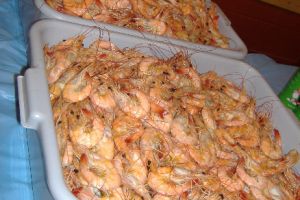
Some of the fishing areas in the Gulf of Mexico are reopening. In fact, this week Louisiana reopened commercial fishing in areas East of the Mississippi. In the coming weeks, we can expect that many more areas will reopen to recreational and commercial fishing.
I'd love to see the Gulf open to fishing, since I think it's important for the economy and culture of the region to have a healthy fishing industry. But fishing shouldn't reopen until it's safe. One of my colleagues in the Gulf reported from a boat this week, showing dispersed oil lurking below the surface. A piece in the Huffington Post cited studies finding dispersed oil under the shells of crab larvae. I keep getting calls from reporters asking "is it safe to eat the fish?"
The answers are complicated and include: "it depends", and "I wish I knew". Here are the problems:
- Most of the data on contamination in Gulf seafood are not publicly available, so scientists cannot independently review the findings and the public is expected to rely on bland assurances from various agencies and elected officials.
- The seafood monitoring that is currently being done may not be adequate, both in terms of sample size and methodology (more on this in a future blog).
- The FDA risk assessment of how much contamination by polycyclic aromatic hydrocarbons (PAHs) in seafood is 'acceptable' is flawed and will not adequately protect public health (more on that in another post soon).
In the short term, oil can coat fish or be incorporated into flesh. This can cause the seafood to look, smell, or taste oily and be unsafe to eat. As the oil breaks down in the environment, other contaminants, such as polycyclic aromatic hydrocarbons (PAHs) and metals, are released into the food chain which can accumulate in seafood and result in contamination. Polycyclic aromatic hydrocarbons (PAHs) are a class of chemicals which have been linked to DNA damage and cancer. Metals, such as mercury, cadmium, and lead can also be found in crude oil. When these metals accumulate they can damage the liver, kidneys, brain, and nervous system.
The dispersant chemicals used to break-up the oil are also a concern. Although the components of the dispersants should break down in the environment and not accumulate in seafood, these chemicals have never been used in such large quantities before and significant gaps remain in understanding how they will impact the environment, fish, and people.; By breaking down the oil into smaller particles, the dispersants may make the contaminants in oil, particularly PAHs, more easily absorbed by fish, crab, shrimp, and oysters.
The unprecedented enormity of this oil spill makes it very difficult to predict the extent and duration of fish contamination. What we know from previous spills is that oil contaminants are processed differently by fish and shellfish and the length of contamination can vary. Fish are more readily able to process PAHs and remove them - so they are expected to be less impacted. Shellfish, like oysters, crabs, and shrimp, are much slower at removing contaminants. One study found that oysters continued to be contaminated seven years after an oil spill. The trace metals in the oil are a time bomb, since they bioaccumulate in the food chain over a period of many years. The highest levels of oil-related metals will likely occur in large fish such as tuna and mackerel many years in the future.
As the various agencies decide when to reopen fisheries, they should be basing their decisions on comprehensive testing and accurate safety assessments not on politics. We are conducting an independent review of the seafood monitoring plan and safety assessments and we will be posting our findings soon.
This post originally appeared on NRDC's Switchboard.
Gina Solomon is a Senior Scientist at the Natural Resources Defense Council in San Francisco. NRDC is a non-profit organization dedicated to protecting the environment, people and animals. NRDC was founded in 1970 and is comprised of more than 300 lawyers, scientists and policy experts, with more than one million members and e-activists.

